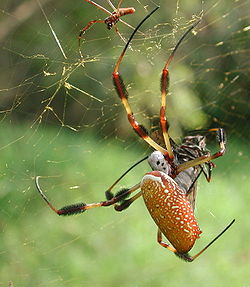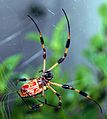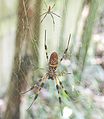- Nephila clavipes
-
Nephila clavipes 
Female feeding (bottom) and male (top) Scientific classification Kingdom: Animalia Phylum: Arthropoda Class: Arachnida Order: Araneae Suborder: Araneomorphae Family: Nephilidae Genus: Nephila Species: N. clavipes Binomial name Nephila clavipes
(Linnaeus, 1767)Synonyms Aranea clavipes
Aranea spinimobilis
Aranea longimana
Epeira clavipes
Epeira plumipes
Nephila wilderi
Nephila wistariana
Nephila concolor
Nephila thomensisNephila clavipes (Lat. clavis — "lock pick" + pedis — "foot") is a species of golden orb-web spider. It lives in the warmer regions of the Americas. The large size and bright colours of the species make it distinctive. The female is much larger than the male.
In the United States, it ranges throughout the coastal southeast and inland, from North Carolina to Texas. Its distribution in many regions seems localized, and it may be completely absent (or just hard to find) over wide areas. Conversely, in some arboreal or swampy nooks, adults and their webs can be found in large concentrations, especially near the coast. Golden orb-weavers are especially numerous in the time after summer and before fall in the south-eastern and southern U.S. This species is widespread — and often common — in large parts of Central America and warmer regions of South America.
The web of a mature female can reach one meter in width, the yellow threads appearing as a rich gold in sunlight. Males come into the female's web for copulating. After mating the female spins an egg sac on a tree, laying hundreds of eggs in one sac. While it is venomous to humans, it will only bite if pinched, and if doing so, the bite is usually relatively harmless and only leads to slight redness and localized pain.[1]
The silk of N. clavipes has recently been used to help in mammalian neuronal regeneration. In vitro experiments showed that a single thread of silk can lead a severed neuron through the body to the site it was severed from. With a tensile strength of 4×109 N/m2, it exceeds that of steel by a factor of six. It is not recognized by the immune system.[2]
Contents
Footnotes
References
- Allmeling, C.; Jokuszies, A.; Reimers, K.; Kall, S. & Vogt, P.M. (2006): Use of spider silk fibres as an innovative material in a biocompatible artificial nerve conduit. J. Cell. Mol. Med. 10(3): 770-777. PDF - doi:10.2755/jcmm010.003.18
- Weems, Jr., H.V., and G.B. Edwards, Jr. 2001 (2004 revision). golden silk spider. on the UF / IFAS Featured Creatures Web site
External links
- Mating pair
- Pictures of N. clavipes (free for noncommercial use)
- Gravity favours smaller males : Review of scientific article on why males are much smaller than females
Gallery
-
Male mating with the female while she eats a bee.

This spider–related article is a stub. You can help Wikipedia by expanding it.












